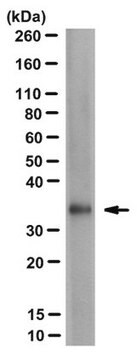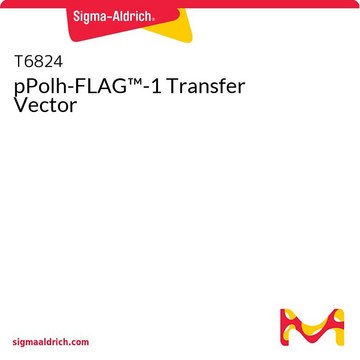MABN2280
Anti-FMR1polyG Antibody, clone 8FM-2F7
ascites fluid, clone 8FM-2F7, from mouse
Synonym(e):
Synaptic functional regulator FMR1, Fragile X mental retardation protein 1, FMRP, Protein FMR-1
About This Item
Empfohlene Produkte
Biologische Quelle
mouse
Antikörperform
ascites fluid
Antikörper-Produkttyp
primary antibodies
Klon
8FM-2F7, monoclonal
Speziesreaktivität
human
Verpackung
antibody small pack of 25 μL
Methode(n)
immunofluorescence: suitable
immunohistochemistry: suitable (paraffin)
western blot: suitable
Isotyp
IgG1κ
NCBI-Hinterlegungsnummer
UniProt-Hinterlegungsnummer
Posttranslationale Modifikation Target
unmodified
Angaben zum Gen
human ... FMR1(2332)
Allgemeine Beschreibung
Spezifität
Immunogen
Anwendung
Neurowissenschaft
Immunohistochemistry Analysis: A representative lot detected FMR1polyG in Immunohistochemistry applications (Buijsen, R.A., et. al. (2014). Acta Neuropathol Commun. 2:162; Sellier, C., et. al. (2017). Neuron. 93(2):331-347).
Western Blotting Analysis: A representative lot detected FMR1polyG in Western Blotting applications (Sellier, C., et. al. (2017). Neuron. 93(2):331-347).
Immunohistochemistry Analysis: A 1:50 dilution from a representative lot detected FMR1polyG in human cerebral cortex and human testis tissues.
Immunofluorescence Analysis: A representative lot detected FMR1polyG in Immunofluorescence applications (Buijsen, R.A., et. al. (2014). Acta Neuropathol Commun. 2:162; Sellier, C., et. al. (2017). Neuron. 93(2):331-347).
Qualität
Western Blotting Analysis: A 1:500 dilution of this antibody detected FMR1polyG in HEK293 cell lysates expressing FMR1polyG.
Zielbeschreibung
Physikalische Form
Lagerung und Haltbarkeit
Sonstige Hinweise
Haftungsausschluss
Sie haben nicht das passende Produkt gefunden?
Probieren Sie unser Produkt-Auswahlhilfe. aus.
Analysenzertifikate (COA)
Suchen Sie nach Analysenzertifikate (COA), indem Sie die Lot-/Chargennummer des Produkts eingeben. Lot- und Chargennummern sind auf dem Produktetikett hinter den Wörtern ‘Lot’ oder ‘Batch’ (Lot oder Charge) zu finden.
Besitzen Sie dieses Produkt bereits?
In der Dokumentenbibliothek finden Sie die Dokumentation zu den Produkten, die Sie kürzlich erworben haben.
Unser Team von Wissenschaftlern verfügt über Erfahrung in allen Forschungsbereichen einschließlich Life Science, Materialwissenschaften, chemischer Synthese, Chromatographie, Analytik und vielen mehr..
Setzen Sie sich mit dem technischen Dienst in Verbindung.








